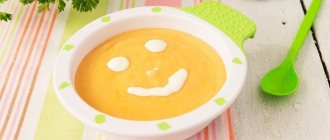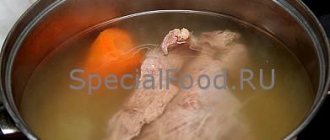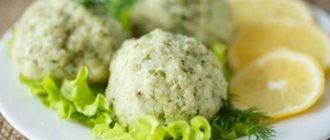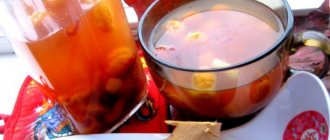Rules for creating a menu for a one-year-old baby
Of course, eating habits vary greatly from family to family.
However, regardless of your culinary preferences, there are a number of rules on which the diet of a 1-year-old child should be based. Rules for creating a menu:
- The food a 1 year old child eats should be as varied and healthy as possible. By the age of one and a half years, food addictions begin to form. And whether you instill a love for healthy foods in your child will determine his future eating behavior. The baby will happily eat baked broccoli and boiled onions in combination with other vegetables.
- It is necessary to follow the feeding regime. Tying meals to the clock will help improve the functioning of the digestive tract and also develop a healthy habit. As a rule, the baby needs five meals, with a break between which should be about three to four hours. Moreover, three of them are main and two are snacks. The schedule should also include breast milk or an adapted formula, depending on what kind of nutrition the child is accustomed to.
- It is quite easy to diversify the menu. It is recommended to give the baby: lean meat and fish, cottage cheese, kefir, all kinds of fruits and vegetables. It is advisable to avoid constant repetition of dishes throughout the week.
- The preferred heat treatment is: boiling, stewing and baking. Closer to one and a half years, you can start experimenting with various spices. However, you need to be especially careful with spicy seasonings and gradually accustom your child to them.
- In addition to nutrition, it is important to maintain a water regime. It is better to accustom your baby to clean water rather than sugar-containing drinks. This will only have a beneficial effect on his health and well-being.
- The menu of a 1-year-old child should be designed so that the daily volume of everything eaten is about 1.2 liters. This must be distributed between four main meals: breakfast, lunch, afternoon snack and dinner. The proportion should be: 25% - 35% - 15% - 25%. In this case, evening kefir and second breakfast may not be taken into account in the calculation.
- According to the rules of complementary feeding according to Komarovsky, each new product should be introduced gradually, starting from ten to fifteen grams per day. It is better to do this not at night, but in the first half of the day. If there is no negative reaction, the amount should be gradually increased. Typically a new product is introduced once a week.
Important! You should not give your baby chocolate or cake. They contain too much fat and sugar. If you want to treat your baby, then preference should be given to marmalade, marshmallows or fruit jam.
Features of a baby's dairy-free diet
If a child is allergic to cow's milk, pediatricians and nutritionists recommend adhering to the following nutritional principles:
- The menu should not include any dairy products, be it sour cream, cottage cheese, or ice cream.
- If parents, after their child consumed a certain product, notice swelling of the skin, a rash on the body, or another allergic reaction, they should abandon this dish completely; individual intolerance is possible.
- The menu is adjusted and regulated in accordance with the consumption patterns of certain substances and vitamins. For example, if a child does not consume dairy foods, a protein deficiency will most likely be diagnosed. To make up for the deficiency, it is enough to lean on lean varieties of meat. You should not treat an allergy sufferer as a patient or, conversely, stuff him with fatty, high-calorie foods. The diet should be healthy - meat should be separated from the skin, and poultry should be boiled, not fried.
- If the baby is still small, formulas based on protein hydrolyzate are indicated in infancy - it will relieve allergies and maintain an effective and necessary amount of protein per day for the normal functioning of the body.
- You are allowed to eat soy dishes along with meat.
- Sweets often cause allergies, but you should not exclude them from your diet completely. Glucose gives the baby strength and energy, without which it is difficult for the child to cope with the tasks assigned to him, to be in a good mood and to show keen interest and curiosity in the world around him.
- In winter, it is advisable to bake vegetables in the oven along with potatoes or prepare delicious steamed vegetable dishes.
- Be sure to seek help from an experienced pediatrician. He must prescribe a calcium supplement to the child, since if milk is excluded, the baby will have a calcium deficiency in the body, and this is fraught with brittle bones and osteoporosis.
What else do leading doctors advise? Support your child to eat healthy. It looks absurd when the family gathers at the table, where the adults eat junk food - fried potatoes, a large amount of flour products, very fatty borscht, eat cakes for dessert, and at the same time the baby is forced to be sad and mischievous, eating buckwheat in water, salad from cucumbers and boiled thigh. Remember that the digestive tract of every person needs weekdays and holidays, and there should be several times fewer buffets per year than regular meals.
Show an example of the correct menu, and very soon your child will become a habit of eating only what is possible and healthy for him. And you will begin to lose extra pounds and feel lighter, healthier and more energetic.
Sample menu for 1 year
We have already figured out what principles a 1-year-old child’s menu should be based on; let’s now figure out what exactly a baby should eat during the day. Because a 1-year-old child’s daily routine should be fairly clearly regulated.
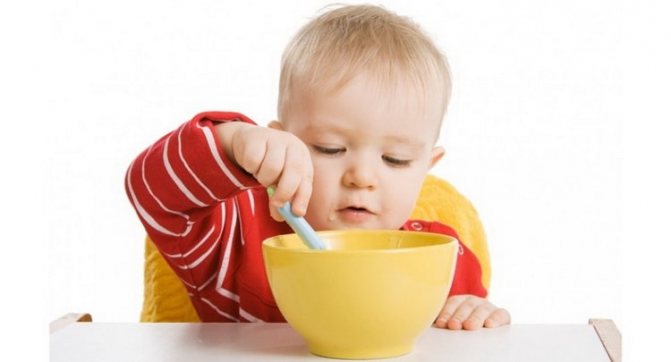
Breakfast
In the morning, it is better to give preference to porridge cooked in water. After cooking, you can add a small amount of milk or a specialized mixture to it. The permissible amount for a 1 year old baby is from 150 to 200 ml. Allowed cereals:
With gluten: semolina, oatmeal, wheat. These cereals are acceptable only if the baby does not show a reaction to this specific protein. But in any case, you shouldn’t get carried away with them. Gluten free: rice, buckwheat, corn. It is better to use porridges for the first feeding from this list.
It is allowed to add butter to the porridge in the amount of five grams per serving, or chicken yolk. You can also complement the menu with fruit puree as a dessert or pour it over porridge. By the age of one and a half years, you can offer your baby breakfast with a steamed omelet or a sandwich with butter and cheese. It is better to choose bread from white flour, because it is better absorbed by the body. Up to 20 grams of butter is allowed per day, and up to 40 grams of bread.
Dinner
The main meal should be taken during the daytime. The baby's lunch should include three dishes: vegetable puree, soup, salad, steamed fish or meat. At the very beginning of the meal, you can eat a small portion of salad from fresh vegetables, finely chopped or grated on a coarse grater. Vegetables should be seasonal; you can give them: cucumbers, tomatoes, radishes or carrots. Low-fat sour cream or vegetable oil is suitable as an addition to the salad; the amount varies from five to ten grams.
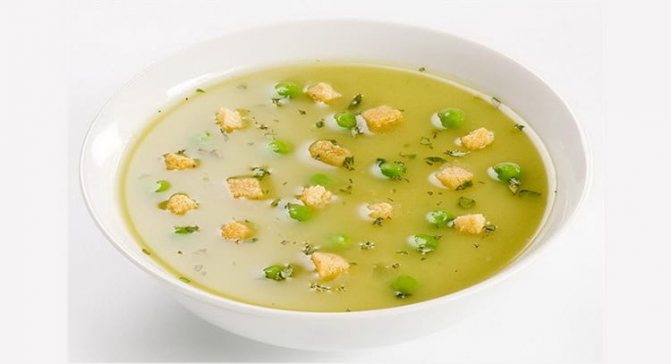
Soups for children:
Milk with noodles – should not be given more than once a week. Amount of soup – up to 35 grams. Vegetable – you should start with ones that are easy to prepare and contain a small amount of ingredients. Gradually, the diet can be expanded and include borscht, cabbage soup, cauliflower soup and other vegetables. They can be given both in the form of puree soups and in their usual form. Make sure your baby chews food thoroughly before swallowing. Vegetable puree with meat or fish. Ingredients that can be used are: pollen, broccoli, carrots and onions. After twelve months, you can also add green peas, beets, turnips and beans. Potatoes should not make up more than a third of the total number of vegetables in the puree. The starch content in this vegetable is very high, which can cause excessive weight gain, increased gas formation and allergies. It is better to use veal, beef and rabbit as meat In this case, the meat should be cooked separately, and not use the broth for making soups. You can make steamed cutlets, meatballs and soufflés. After twelve months of age, chicken is introduced into the menu, as well as liver and other offal. Fatty and difficult to digest meats should not be consumed until two or three years of age. Sausages are also not advisable during this period. as a fish dish on the menu. It is optimal to steam small hake and pollock. Twice a week will be enough to saturate the body with iodine and protein.
Afternoon snack
Fermented milk products are ideal for a snack after a nap .
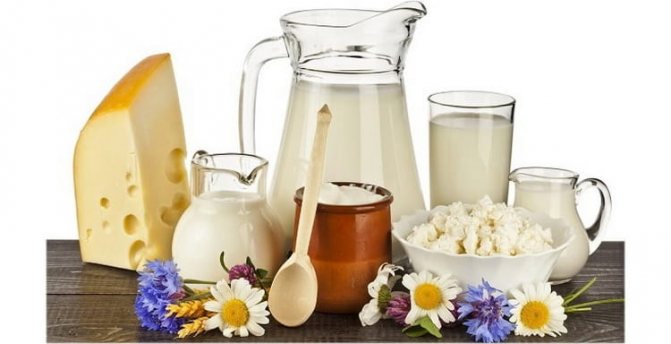
Kefir and cottage cheese will not only fill the need for calcium, but will also help the baby not feel hungry until dinner. It is not necessary to give cottage cheese in its pure form; you can prepare cheese pancakes, pancakes with cottage cheese and cottage cheese casseroles for the little ones.
As an afternoon snack, your child can also be given biscuits with juice and fruit puree. The juice should not contain a lot of sugar. This is not advisable for a 1 year old child's menu. Cottage cheese and kefir , which are given to a little person in raw form, must be specially produced for children of the specified age group. Homemade cottage cheese must undergo heat treatment.
Dinner
In the evening, preference should be given to vegetable dishes with meat or all kinds of cereals. Food should be nutritious and light at the same time, so as not to overload the digestive tract. Acceptable dinner menu:
- zucchini soufflé with meat puree;
- steam cutlets and vegetable stew;
- porridge with added pumpkin;
- beets stewed with apples.
An omelet for a 1-year-old child should be carefully introduced into the diet, although the recipe can be found online. Eggs are a fairly strong allergen and can cause a negative reaction.
After the main meal, you can please your baby with fruit puree. You can gradually introduce exotic fruits and berries into your diet, according to their ripening season.
Snack before bed
It is not advisable to put your baby to bed on an empty stomach. Before going to bed, you can feed with breast milk or a special formula. Fermented milk drinks are also allowed.
What should a 1 year old child's menu be like?
To answer this question, you need to know what components of the product he needs. The child becomes more mobile. Many are already starting to walk and talk. To replenish energy costs, the baby requires proteins, carbohydrates, minerals and B vitamins in greater quantities than before. Porridges are rich in these contents. Before he was one year old, the baby had already tried pureed buckwheat, oatmeal and rice porridge. At the age of 1 year, you can add wheat or corn porridge to the child’s menu, and now you just need to boil them well. If a child has milk intolerance, such porridges can be cooked with vegetables or simply with water.
The baby continues to grow quickly. This means that he still needs fermented milk products that contain protein, calcium, sodium, chlorine and phosphorus. In addition, “live” yoghurts are healthier. This should be taken into account if you did not know before what to feed your baby at 1 year old. The baby's menu should be balanced.
A one-year-old child will like cottage cheese diluted with a fermented milk product, as well as crushed cheese, which can be sprinkled on puddings. You can offer your baby a sandwich made of bread with butter. It should be taken into account that the content of B vitamins and vitamin E in rye bread is higher than in white bread, but it has the ability to cause bloating.
You can include pasta in a 1-year-old child’s diet, but do not do this more than 3 times a week. They contain complex carbohydrates, B vitamins and fiber.
A child’s diet should always include soups, vegetable and fruit purees to replenish the body with vitamins, microelements and other beneficial substances, without which it is impossible to fully develop. You need to use beets, carrots, legumes, cauliflower, as well as sweet varieties of pumpkin to prepare vegetable purees. Fruits such as peaches and apricots can be cut into slices rather than mashed.
A special place in the diet of a one-year-old baby should be occupied by meat, liver, eggs, as well as fish, which are suppliers of protein. In addition, including beef or chicken liver in the menu will significantly enrich the growing body with iron, iodine, zinc, calcium, and vitamins A, B, D.

Dosages and volumes
A 1-year-old child's diet should be varied and nutritious. In this case, the principle applies very well: better quality is better than more. The volume of food per day should be about 1.2 liters. In this case, food intake should not exceed 300 ml, because this figure characterizes the volume of the baby’s stomach. If you count it in calories, then the baby should receive approximately 100 kcal for every kilogram of weight.
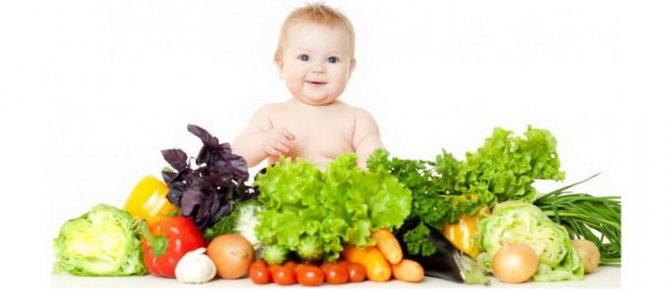
Daily amount of main products on the menu:
- Dairy products - up to 600 ml, of which 200 ml should be kefir, and 50 grams should be cottage cheese.
- Eggs – half a chicken or a whole quail, hard-boiled.
- Meat – up to 100 grams per day.
- Fish – up to forty grams per meal, up to two times a week.
- Porridge – up to 200 ml.
- Oil – vegetable (6 grams), butter (up to 15 grams).
- Vegetables – up to 200 grams.
- Fruits – 100 grams.
- Berries – 15 grams.
- Water – without limitation, it should be given on demand, and do not replace all the liquid with compote and tea.
Diet features
It is from this age that the baby is no longer considered a baby, although doctors recommend continuing breastfeeding until 22-24 months. As a rule, breast milk is included in the menu of a child of this age as an early breakfast or a late-night snack.
Since it is impossible to overfeed a baby with breastfeeding, there is nothing wrong with this, quite the opposite: according to recent studies, mother’s milk prevents the occurrence of caries by delaying the growth of staphylococcus.
But if your baby takes a bottle of formula or juice at night, then you should wean him off this. Unlike breast milk, formula and juices provoke the development of caries, since they disrupt the acid-base balance in the oral cavity, which can cause destruction of tooth enamel. By the age of 1.5 years, the child should be weaned from eating at night, because this disrupts sleep and appetite during the day.
Since by the age of one year babies, as a rule, already have 6-10 teeth, it is worth adding pieces of food to their menu that are not ground into a puree to develop the chewing reflex. The baby should eat 4-5 times a day at approximately the same time with a deviation of 15-20 minutes.
This regime corresponds to the metabolism of the baby, whose stomach is cleared in about 4 hours. If you do not take into account liquids, then a child eats 1200-1250 g of food per day, which is the norm.
This volume is divided into the following portions:
- breakfast and second breakfast – 25%;
- lunch – 35%;
- afternoon snack – 15%;
- dinner – 25%.
The calorie content of the daily diet is approximately 1200-1300 kcal.
You should not teach your child to have snacks between main meals - this worsens appetite.
Prepared meals or home-cooked meals
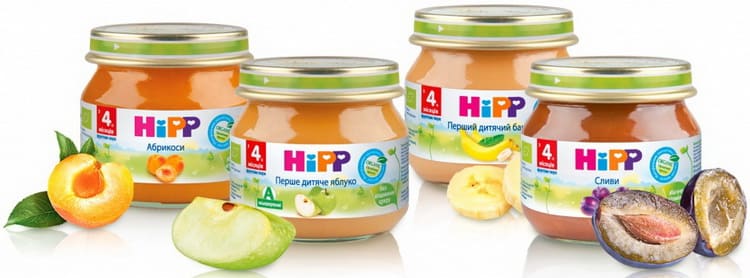
There are two opposing expert opinions on this matter: some believe that store-bought food is optimally balanced, while others believe that there is nothing better and healthier than homemade food. However, a 1-year-old child’s diet should be well balanced in terms of protein, fat and carbohydrate content.
It is optimal to find a balance between store-bought vegetable and fruit purees and homemade food. It is better to choose trusted baby food manufacturers and carefully study the label so that the sugar content is not too high. Sometimes in a homemade recipe the amount of carbohydrates and fats is also off the charts.
Kitchen helpers

Currently, stores offer a huge amount of equipment that can be useful to a young mother. A blender is perfect for making purees. A steamer allows you to steam meat and fish, as well as healthy vegetables.
An increasing number of mothers prefer to buy yogurt makers, with which they can prepare fermented milk products at home. This allows you to know for sure that the product does not contain harmful impurities and additives.
Menu for a one-year-old baby
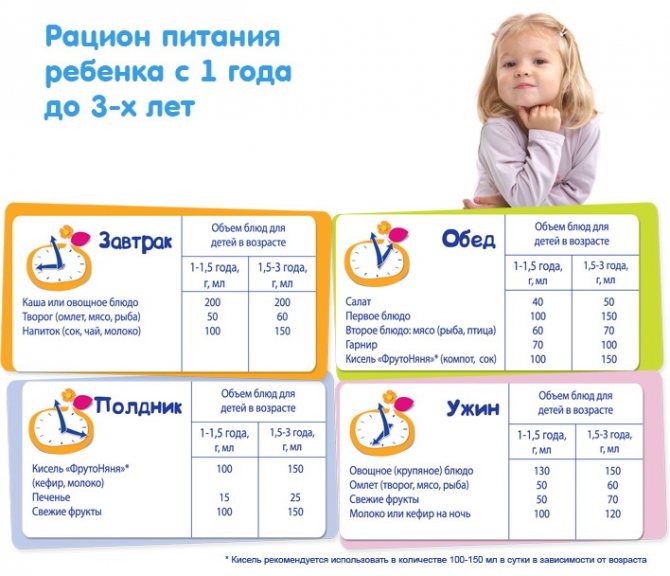
After a year, it is preferable to give children mushy dishes if they have not yet developed chewing teeth, and whole pieces of food (2-3 cm in diameter) if they already have teeth. It is necessary to accustom the child to different tastes so that in the future he does not refuse certain foods.
Porridge and bakery products
Oatmeal and buckwheat are considered especially healthy; corn, rice and wheat porridge are also useful. You can start introducing barley, multigrain, rye and other baby cereals into your baby’s menu. It is better to make them of a uniform consistency by preparing instant (soluble) cereals, then it will be easier for the baby to chew and swallow.
The easiest way to prepare porridge without a long cooking process, preserving its beneficial properties, is to pre-soak it. The cereal will absorb water, soften and swell, then all that remains is to cook it a little until it is fully cooked.
When making oatmeal, it is better to use whole oats. Buckwheat porridge can be poured with milk before serving to the baby, or you can add a little butter. It is worth remembering that even after the first year, doctors still recommend gluten-free cereals.
It is better not to overuse pasta because it contains a lot of easily digestible carbohydrates. They can be offered to your baby 1-2 times a week as a seasoning for soups or a side dish for meat.
From one year onwards, children can be offered bread, preferably white, since the sour dough of rye bread causes fermentation and enhances intestinal motility. Bread in the diet should not be more than 100 g per day. It is better to offer it as an addition to soup or as a sandwich with butter.
Fruits, vegetables and berries
By the age of 1, the child’s menu should include fruits, vegetables and berries. But, if your baby is prone to allergies, you should not experiment without first consulting with an allergist.
Fruits should be given to the child after the main meals; you can also mix them with cereals. They are rich in vitamins, microelements and fiber, and also have a sweet taste that can be used to “embellish” other foods. It is better to grind berries and fruits with thick skins into puree, and with soft ones - cut into slices.
If you mix fruits or berries with milk, you can pamper your baby with a delicious smoothie. The daily norm for children is 100-250 g of fruits and about 10-20 g of berries. In addition, 100-150 ml of fruit or berry juice is allowed after the main meal. However, it is not advisable to give jelly to babies - they are rich in carbohydrates, while their nutritional value is low.
Vegetables are also important for enriching the body with useful elements, mineral salts and dietary fiber. They form the basis of nutrition for children of any age. You need to be careful when including legumes in your diet, as they affect intestinal function and can cause abdominal pain.
Vegetables should be offered in pureed form until your baby has chewing teeth. When your child turns one and a half years old, you can try stewed vegetables with small pieces. Garden vegetables and herbs should be introduced into the diet after 18 months. Potato dishes should not exceed 150g per day, and young children should not be offered radishes, turnips or radishes.
The menu for a baby over one year old should include:
- strawberries, cherries, sweet cherries, currants, sea buckthorn, raspberries, blackberries, cranberries, lingonberries, bananas;
- kiwi, apricots, peaches, pears, apples, lemons, oranges, tangerines, grapefruits;
- carrots, cauliflower, beets, turnips, tomatoes, pumpkin, broccoli, zucchini.
It must be remembered that grapes enhance fermentation in the intestines and at the same time have low nutritional value. You should stay familiar with this product for up to three years.
Dairy
Dairy products owe a significant role in children’s nutrition not only to the beneficial substances in their composition, but also to lactic acid bacteria, which improve digestion. Dairy and fermented milk products should be present in a child’s diet every day. The daily dose of kefir is 200 ml, and yogurt 200-300 ml.
It is better to give your baby special yoghurts: for children or with a limited shelf life of no more than two weeks. Such products do not undergo heat treatment and retain bacteria beneficial to children's intestines.
Among non-children's yogurts, you should choose low-fat, dairy, not creamy ones, and monitor the amount of preservatives, sucrose and artificial additives in the composition.
An important part of a child's menu by the age of 1 year is cottage cheese. After a year, its amount can reach 70 g per day or 140 g every two days. Cottage cheese is useful, both in its pure form and in any dish. Cheese is also important in a baby's diet.
It can be grated as a seasoning for pasta or as a small snack in itself. Hard pieces of cheese will develop a chewing reflex in your baby, so offering them to him is very important.
The daily intake of animal oil is up to 17 g per day. It is better to add butter to pasta, cereals, or make sandwiches for your baby for an afternoon snack. Low-fat sour cream makes an excellent salad dressing or addition to other dishes.
Dairy products can be offered to your baby in the following forms:
- smoothie – beat kefir with seasonal fruits in a blender;
- fruit salad dressed with yogurt;
- milk porridge;
- steamed omelette;
- cottage cheese casserole with sour cream;
- milk soup with noodles;
- cottage cheese with pieces of fruit;
- pudding.
Don't rush to give up formula milk!
It is better to postpone introduction to cow's milk until two years, in order to avoid the occurrence of allergic reactions.
Eggs, fish and meat
Animal protein is as important for a growing body as any other element, so children should not be put on a vegetarian diet. The daily allowance of meat for children is 100 g. You can use both animal and poultry meat and offal (liver, heart, brains, tongue).
Waterfowl meat is difficult to digest, so it should not be offered too often. You should prepare dishes from minced meat (cutlets, meatballs, soufflé, meatballs). Towards the middle of the second year, when the baby has chewing teeth, you can offer stewed meat with whole pieces. Immediately after one year, it is best to prepare steamed cutlets for the baby. You can also add baby sausages to your diet.
Fish is also an important part of the diet. It should be offered once or twice a week in the form of steamed cutlets or meatballs. Stewed fillet is allowed. Fish is rich in iodine, which has a positive effect on brain development and thyroid function. For a one-year-old child, low-fat varieties of river and sea fish are best suited: hake, cod, pollock.
Children over the age of one year cannot eat without eggs. Protein is absorbed almost completely by the child’s body. Food should include quail and chicken eggs.
Waterfowl eggs can carry dangerous infections, so you should postpone their consumption. Only hard-boiled eggs should be offered as food. Raw eggs, soft-boiled or boiled in a bag, are less digestible. You can also pamper your baby with an omelet.
If you cook it in the microwave, the crust will not form and it will be baked instead of browned like in a frying pan. Since eggs are highly allergenic, you should not offer them to your child more than every other day. They can be added to vegetable puree or offered along with porridge.
Meat, fish and eggs can be cooked or added to other dishes as follows:
- steam cutlets for porridge or vegetable salads, meatballs, meatballs for soup, soufflé;
- canned fish and vegetable baby food;
- eggs - in soup or salad;
- omelette.
It is worth remembering that only lean varieties of meat are suitable for feeding children.
Delicious and healthy recipes
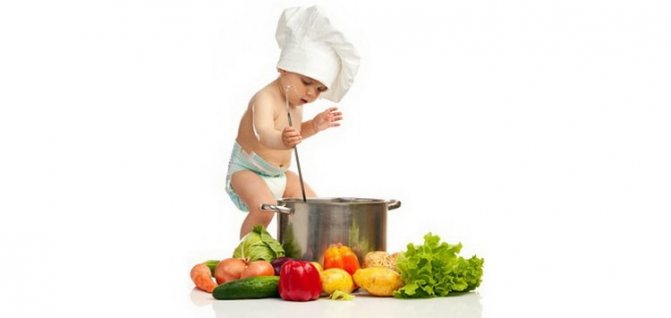
We present you some recipes for children aged 1 year and older. Their number is huge on the World Wide Web and finding a suitable recipe is not difficult.
Meat or fish dishes
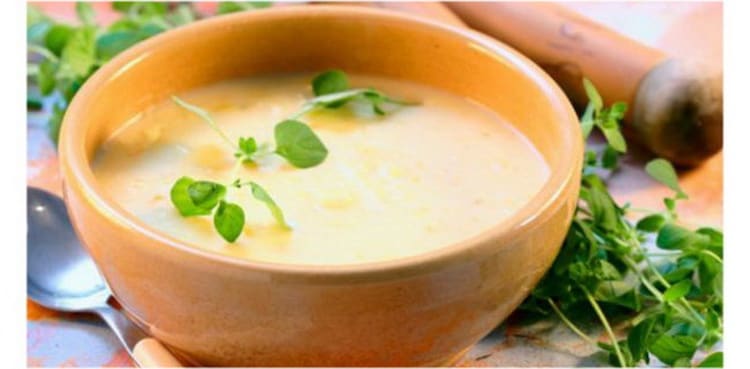
Chicken puree recipe
Ingredients:
| Product | Quantity |
| Chicken breast | 200 g |
| Potato | 1 PC. |
| Carrot | 1/2 pcs. |
| Onion | 1/2 pcs. |
| Zucchini | 100 g |
| Water | 300 ml |
You need to chop the chicken breast and fry it without oil in a frying pan, add the onion and simmer a little. Add zucchini, carrots and potatoes to the pan and add water. Add a little salt and simmer until done. Blend in a blender until pureed.
Fish puree recipe
Ingredients:
| Product | Quantity |
| Pollock | 100 g |
| Potato | 100 g |
| Water | 500 ml |
Cut the pollock and put it in a cooking container. Add a glass of water and cook until the fish is very soft. Separately, boil the potatoes in the remaining water until they can be easily pierced with a fork. Drain the water, add the potatoes to the fish and mash everything with a fork, once again checking the fish for bones.
Recipes for vegetable and meat soups
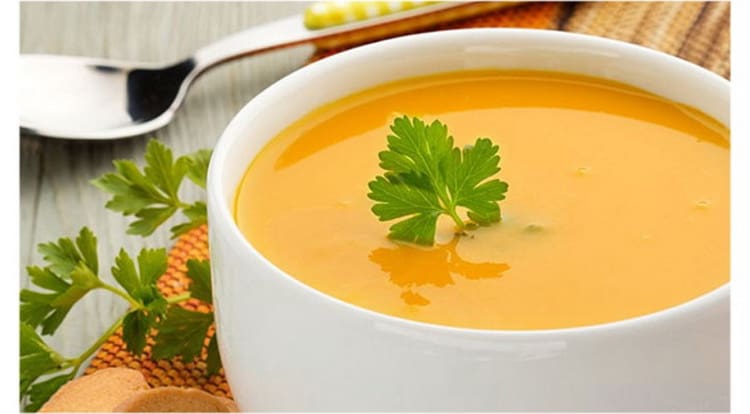
Cauliflower Soup Recipe
Ingredients:
| Product | Quantity |
| Cauliflower | 700 g |
| Potato | 200 g |
| Onion | 1 PC. |
| Butter | 1 tsp. |
| Cream | 100 ml |
Chop the onion and fry it in butter. Add chopped potatoes and cabbage florets to the pan. Fill with water and add salt to taste. Cook until the vegetables are ready. Grind with a blender. Add cream and a little broth to thin out the soup.
Veal soup recipe
Ingredients:
| Product | Quantity |
| Veal | 200 g |
| Potato | 1 PC. |
| Onion | 1 PC. |
| Zucchini | 200 g |
| Carrot | 1 PC. |
The veal must be cut into pieces and boiled until cooked. Finely chop the vegetables and cook in a liter of water until tender. Add salt to taste. Grind the meat using a meat grinder and add to the finished soup.
Porridge recipes
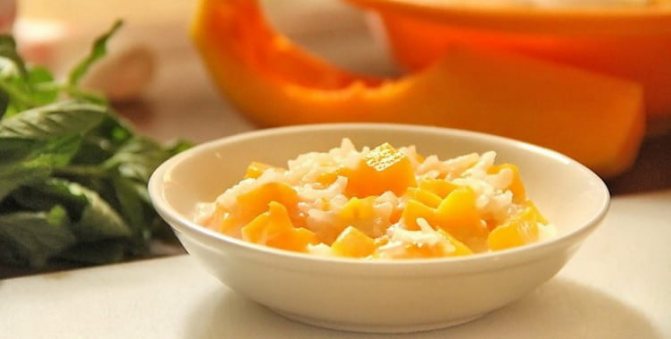
Recipe for rice porridge with pumpkin
Ingredients:
| Product | Quantity |
| Rice | 1 stack |
| Milk | 1 stack |
| Pumpkin | 400 g |
| Butter | 1 tsp. |
Grate the pumpkin and put it in a saucepan, add 2 cups of water and cook for 15 minutes. Add pre-soaked rice and simmer for 8 minutes over low heat. Pour in a glass of boiled milk and simmer the porridge for another 15 minutes. A minute before cooking, add butter and sugar if desired. Cover with a lid and let stand.
Recipe for semolina porridge on water
Ingredients:
| Product | Quantity |
| Semolina | 3 tbsp. l. |
| Water | 300 ml |
| Salt and sugar | taste |
| Butter | 1 tsp. |
Pour water into the pan and bring to a boil. Add semolina in a thin stream, stirring constantly. Cook over low heat, remembering to stir. Add sugar and salt. Remove from heat and add oil.
Menu for a child (1 year 3 months) with a severe allergy to all dairy
| 8.15 — 8.30 – Breakfast 1: | 10.15 – 10.30 – Breakfast 2: | 12.30 – Dinner: | 16.00 – 16.30 – Afternoon snack: | 18.30 – Dinner: | |
| Mon | + Buckwheat porridge “Malyutka” / “Remedia” dairy-free – 220-250 g + Yolk (quail) – ½ + Tea with rose hips “Babushkino Lukoshko” / Water | + Fruit salad (apple+pear) – ½ + ½ + Tea / Water | + Vegetable puree soup (potatoes, onions, carrots, dill, parsley) with rice and meat puree (turkey) – 250 g + Bread – 5 g + Fresh onions (snack) + Compote of dried fruits (apple, pear, prunes, dried apricots) | + Oat flakes with pear puree – 220 g + Tea with rose hips “Babushkino Lukoshko” / Water | + Hipp “Rabbit with broccoli and rice” – 220 g + Bread – 5 g + Dried fruit compote / Water |
| VT | + 7-grain porridge “Malyutka” dairy-free – 220-250 g + Banana (!) – 1/4 + Tea with lemon balm “Babushkino Lukoshko” / Water | + Fruit and vegetable salad (apple-carrot “Carrot”) – ½ + 4-5 pieces of carrots + neraf oil. "Gold" + Tea/Water | + Stewed cauliflower (cauliflower, potatoes, onions, carrots, dill, parsley) with meatballs (pork, rice) – 220-250 g + Bread – 5 g + Fresh onion (as a snack) + Fresh apple compote | + Gerber puree “Prunes + apple” – 125 g + Tea / Water | + Meat puree (turkey) with mashed potatoes (potatoes, onions, dill) – 220-250 g + Bread – 5 g + Fresh apple compote |
| SR | + Dairy-free oatmeal “Baby” – 220-250 g + Dried fruit compote (apples, pears, dried apricots, prunes) | + Fresh apple – 1/2 + Tea / Water | + Stewed zucchini (zucchini, onions, carrots, dill) with rice and meat puree (chicken) – 220-250 g + Bread – 5 g + Fresh onion (as a snack) + Dried fruit compote / Water | + Gerber puree “Prunes + apple” – 125 g + Tea / Water | + Stewed vegetables from a frozen mixture (cauliflower, green beans, broccoli, carrots) with buckwheat and meat puree (turkey) |
| Thu | + Heinz dairy-free corn porridge – 220-250 g + Yolk (quail) – ½ | + Fresh apple – 1/2 + Tea / Water | + Vegetable puree soup (potatoes, onions, carrots, parsley) with meat puree (turkey) – 220-250 g + Bread -5 g + Fresh onion (as a snack) + Dried fruit compote / Water | + Oat flakes with pear puree – 220 g + Tea with rose hips “Babushkino Lukoshko” / Water | + Hipp “Rabbit with broccoli and rice” – 220 g + Bread – 5 g + Dried fruit compote / Water |
| PT | + 7-grain porridge “Malyutka” dairy-free – 220-250 g + Baked zucchini pancakes (zucchini, dill, flour) – 1-2 pcs + Tea with lemon balm “Babushkino Lukoshko” / Water | + Fruit salad (apple+pear) – ½ + ½ + Tea / Water | + Stewed potatoes with chicken (potatoes, carrots, onions, dill, parsley and separate meat puree (chicken) + Bread – 5 g + Tea “Babushkino Lukoshko” / Water | + Gerber puree “Prunes + apple” – 125 g + Tea “Babushkino Lukoshko” / Water | + Boiled vegetables (from a frozen mixture: cauliflower, broccoli, carrots, zucchini) with meat puree (turkey) – 220-250 g + Bread – 5 g + Red currant compote (diluted with water) / Water |
| SB | + Buckwheat porridge “Malyutka” / “Remedia” dairy-free – 220-250 g + Yolk (quail) – ½ + Tea with rose hips “Babushkino Lukoshko” / Water | + Fruit and vegetable salad (apple-carrot “Carrot”) – ½ + 4-5 pieces of carrots + neraf oil. "Gold" + Tea/Water | + Stewed vegetables (cauliflower, carrots, onions, dill, parsley) with meatballs (pork, rice) – 220-250 g + Bread – 5 g + Fresh onion (as a snack) + Dried fruit compote / Water | + Gerber puree “Prunes + apple” – 125 g + Tea / Water | + Mashed potatoes with meat puree (turkey, dill) – 220-250 g + Dried fruit compote / Water |
| Sun | + 7-grain porridge “Malyutka” dairy-free – 220-250 g + Tea with lemon balm “Babushkino Lukoshko” / Water | + Fruit salad (apple+pear) – ½ + ½ + Tea / Water | + Stewed vegetables (cauliflower, carrots, onions, dill, parsley) with meatballs (pork, rice) – 220-250 g + Bread – 5 g + Fresh onion (as a snack) + Dried fruit compote / Water | + Oat flakes with pear puree – 220 g + Tea with rose hips “Babushkino Lukoshko” / Water | + Vegetable puree soup (potatoes, onions, carrots, parsley) with meat puree (turkey) – 220-250 g + Bread -5 g + Fresh onion (as a snack) + Dried fruit compote / Water |
CAREFULLY:
- have an allergic reaction to banana (red rash on wrists and knees + cheeks)
- have an allergic reaction to fresh carrots (similar)
— fish was previously introduced from jars, we don’t use it now, but we plan to try again
- chicken liver
- tomatoes
- corn, green peas (from frozen mixed vegetables)
EXCLUDED:
- milk and all its derivatives (kefirs, yoghurts, curds, etc., etc.) due to an acute allergic reaction (angioedema occurred due to 2 tsp of TEMA cottage cheese)
- cookies (since they contain milk)
- butter (similar)
- beef and veal
- fruit purees (with exotic fruits such as pineapple - does not eat)
- white cabbage was not introduced (severe flatulence...)
Beverages

It is better to give preference to clean water. But it can be supplemented with other drinks. Allowed: weakly brewed tea, jelly, seasonal fruit compote or natural juice. It is better to minimize the amount of sugar in drinks and eliminate it if possible.
Whole milk is usually a rather heavy product for a 1-year-old baby, so it is better to postpone its consumption. It can be perfectly replaced with kefir.
Nutritional features at 1 year
The menu of a child aged 1 year is formed taking into account the existing diet in the family and compliance with the following rules:
- Dishes may be lumpy or completely pureed.
- During the day the child is fed 5 times.
- Meals should occur at the same time.
If you haven't already stopped breastfeeding, do it only in the morning or evening.
The mixture can also be left, but a replacement in the form of fermented milk products would also be appropriate. Find out at what age you can breastfeed your baby and whether you should take pills to stop lactation.
The daily menu for a one-year-old child should contain:
- vegetables in any form;
- fruits;
- protein (meatballs, cutlets, etc.);
- fats in the form of butter and vegetable oils and sour cream;
- various cereals.

Important! Fish can be given no more than 2 times within 7 days.
In addition to teas, milk and sour milk, the baby also needs to drink clean water. Let's look at what a one-year-old child's menu for a week should look like, with recipes for some dishes.
